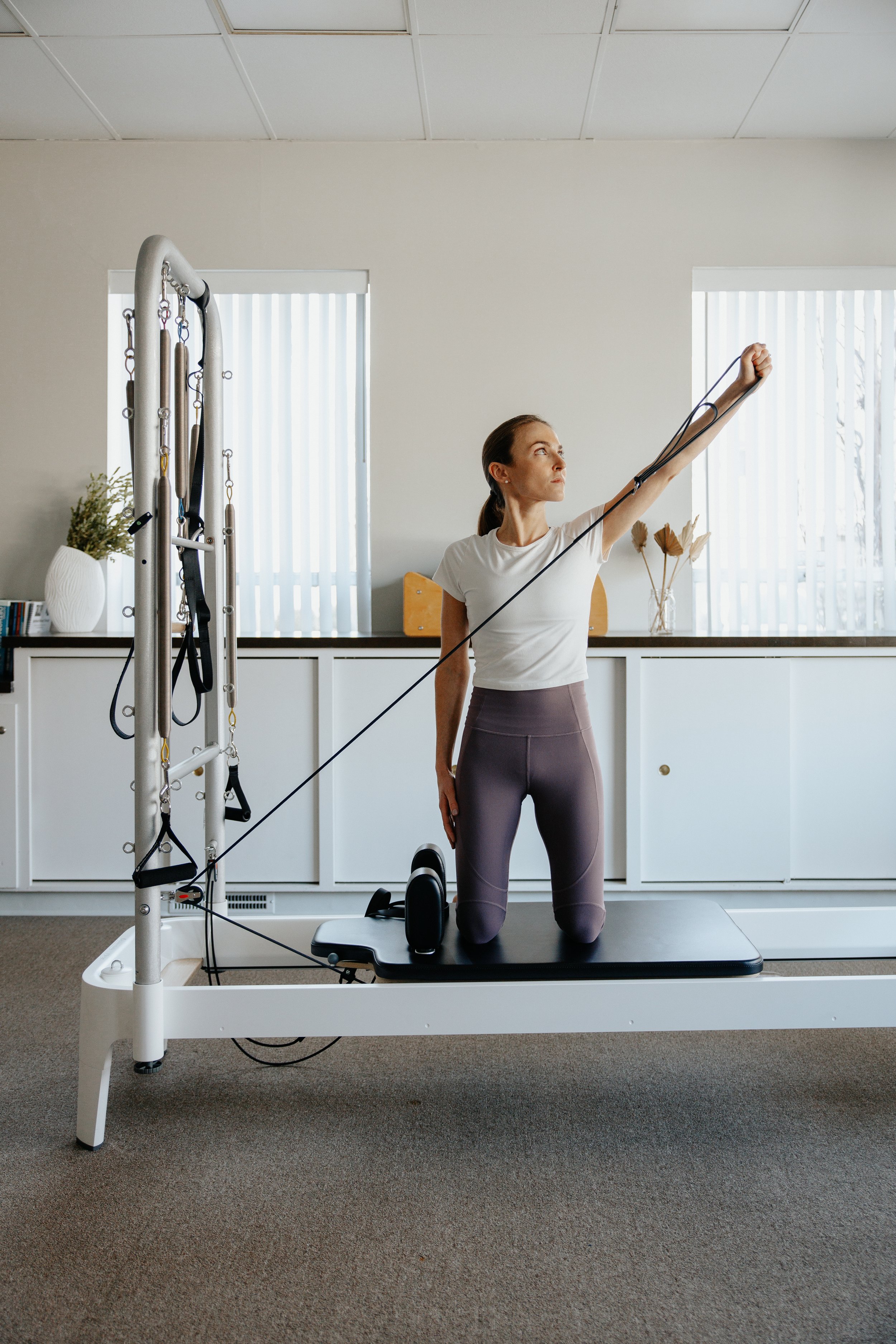Combat Sitting & Slouched Posture with Leg Pull Back
Dr. Jess Forgione, PT performs leg pull back on the mat
In our everyday life…. phones, tv, computers, remote and desk work…. we often spend too much time in seated, or slouched postures. Prolonged time in these positions shortens the front of our body (think the shoulder, elbow, and wrist flexors, pecs, and hip flexors), and inhibits our extensor muscles (upper back extensors, scapular retractors, glutes and hamstrings). Habitual time in poor seated or slouched postures can lead to forward head posture, rounded shoulders, and tightness in our chest and hip flexors, as well as weakness in our upper back and hip extensor muscles.
In order to prevent this, it is important to incorporate exercises that counteract sedentary posture… cue Pilates! Pilates optimizes both mobility and stability with an emphasis on achieving a balanced body. Leg pull back is an advanced pilates exercise that combats the negative side effects of sitting and slouched posture. Leg pull back opens the front body, strengthens the posterior chain, back body, and builds stability in the shoulders, spine, pelvis, and hips. Today’s blog post will give you the tools to work towards mastering the advanced leg pull back. This guide will show you how to start with the basics and work up to the full exercise. We would rather you perform a more basic version with better form, than a more advanced version and fall into one of these common mistakes: sinking into shoulders and hips, and or hyperextending elbows and knees. Try these steps:
1) Improve mobility and flexibility of your shoulders, chest, and hip flexors
Even if you have the most ergonomic workstation possible, our bodies aren’t meant to sustain one posture for prolonged periods of time. We recommend that you take frequent posture breaks throughout the day, including a few deep breaths, a short walk, and some gentle stretches like the chest and hip stretches shown here.
Next up: Once you have the mobility to move through a bigger range of motion, it is time to strengthen and build stability to give your body the support it needs to sustain good posture.
2) Improve the strength and stability of your shoulder girdle, scapula retractors and depressors, and upper back extensors. Try the following 3 exercises to do so!
a) “pulling sword”
At home you can anchor a light theraband at hip level, start by reaching into your pocket across the body, exhale as you open up on the high diagonal pull the band up and across the body with a straight arm, finishing with the hand above the head and out to the side; in the studio give draw a sword demonstrated by Dr. Jess Forgione, PT here on the reformer a try (for added core and hip stability challenge!).
b) bridging
Gently press your hands into the mat opening your chest and engaging your upper back, take an inhale, exhale and press through your heels engaging your glutes to lift your hips off that mat. Think of reaching your knees long past your toes, allowing the front of your hip to release while engaging your back body.
c) leg springs on the tower
This is a great place to work on core activation, trunk & pelvis stability, and firing up those hip extensors (glutes and hamstrings). We’ll start with your back supported on the mat, and eventually work up to magician shown here (we’ll break this down in a future post!)
3) Find & learn “opposition” ! Stretching must be combined with strengthening for long term lasting results! Our bodies have to learn how to stabilize and control movement through increased range of motion. Below, Dr. Allie Duffy, PT is demonstrating a prep for another advanced exercise parakeet, and maybe another future post topic ; ) The pilates principle of opposition is key here- moving your body in two or more directions while engaging different muscle groups and demanding more control and precision.
Finally, here is a great “at home” modification to try leg pull back! Start with a table top version, with your hands elevated to reduce stress on the shoulders.
Start: sit with your feet parallel sit bones distance apart, place hands under your shoulders (elevated will make it easier on your shoulders) fingers pointed in the same direction as your toes (or out to the side may feel easier on wrist).
Inhale to prepare, exhale connect to your core, press through your heels engaging your glutes, and press through heel of your hands firing up upper back extensors, scapula stabilizers, and triceps to lift our hips off the ground and level hips and shoulders.
Maintain your hips level, head in line with your spine, and focus on widening collar bones and opening your chest to the sky, knees will be parallel and over your feet. Think opposition- reaching through the crown of your head in one direction and tailbone and knees in the opposite. Then slowly lower down.
Start with repeating building up to x10 reps. Then you can work on endurance and hold for longer, eventually progressing to performing with straight legs in reverse plank. Once you build endurance here- you are ready to attempt the added stability challenge with the leg lift in leg pull back!
What other exercises would you like to see featured in future blog posts? Comment below!
By Dr. Jess Forgione, PT of The Pilates Rx.








